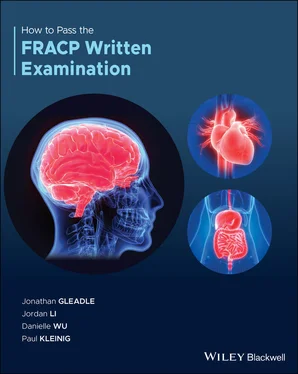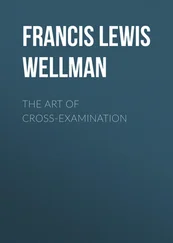
Global Initiative for Asthma – Global Initiative for Asthma – GINA [Internet]. Global Initiative for Asthma – GINA. 2020 [cited 7 July 2020]. Available from: http://www.ginasthma.org
18. Answer: D
This patient has clinical evidence of severe and complicated Clostridium difficile infection (CDI). The incidence of CDI continues to rise. Oral vancomycin 125 mg four times daily is recommended as first‐line therapy for severe CDI. It can be administrated via nasogastric tube or per rectum. Oral metronidazole 400 mg three times daily for 10 days is recommended as first‐line therapy for first episode mild CDI. Fidaxomicin, a first‐in‐class macrocyclic bactericidal antibiotic, has targeted bactericidal activity against C. difficile through inhibiting clostridial RNA polymerase. Fidaxomicin demonstrates minimal impact on normal gut flora and spares Bacteroides spp ., a major ‘protective’ constituent of faecal flora. Fidaxomicin has minimal oral absorption like vancomycin and a prolonged post‐antibiotic effect and has been approved by the Therapeutic Drug Administration (TGA) for use in CDI. Oral fidaxomicin 200 mg twice daily is a treatment alternative in recurrent CDI. Faecal microbiota transplantation (FMT) is a treatment option alternative in recurrent CDI for appropriately selected patients.

Trubiano J, Cheng A, Korman T, Roder C, Campbell A, May M et al. Australasian Society of Infectious Diseases updated guidelines for the management of Clostridium difficile infection in adults and children in Australia and New Zealand. Internal Medicine Journal. 2016;46(4):479–493.
https://onlinelibrary.wiley.com/doi/epdf/10.1111/imj.13027
19. Answer: B
Sepsis is life‐threatening organ dysfunction caused by an infection‐induced dysregulated host response, which may be complicated by septic shock. Sepsis and septic shock are major causes of morbidity and mortality worldwide. The Surviving Sepsis Campaign (SSC) has strongly emphasised the importance of speed and appropriateness of therapy in improving outcomes. Since the application of the first SSC guidelines, a substantial reduction in mortality has been reported. Both sepsis and septic shock should be viewed as medical emergencies requiring rapid diagnosis and immediate intervention.
The hour‐1 bundle encourages clinicians to act as quickly as possible to obtain blood cultures, administer broad spectrum antibiotics, start appropriate fluid resuscitation, measure lactate, and begin vasopressors if clinically indicated. Ideally these interventions would all begin in the first hour from sepsis recognition but may not necessarily be completed in the first hour.
SSC Hour‐1 Bundle of Care Elements:
Measure lactate level, remeasure lactate if initial lactate is elevated (>2 mmol/L).
Obtain blood cultures before administering antibiotics.
Administer broad‐spectrum antibiotics.
Begin rapid administration of 30 mL/kg crystalloid for hypotension or lactate level ≥4 mmol/L.
Apply vasopressors if hypotensive during or after fluid resuscitation to maintain MAP ≥65 mm Hg.

Rhodes A, Evans L, Alhazzani W, Levy M, Antonelli M, Ferrer R et al. Surviving Sepsis Campaign. Critical Care Medicine [Internet]. 2017 [cited 21 June 2020];45(3):486–552. Available from: https://journals.lww.com/ccmjournal/Fulltext/2017/03000/Surviving_Sepsis_Campaign___International.15.aspx
20. Answer: B
The ECGs show
1 Left bundle branch block
2 Mobitz type II 2:1 heart block
3 Bifascicular block
4 Mobitz type I (Wenckebach) heart block.
Temporary transvenous pacing is necessary for patients with severe and symptomatic bradyarrhythmias. It should be considered for patients with second‐degree or third‐degree atrioventricular (AV) block associated with symptoms or hemodynamic compromise. Temporary transvenous pacing is necessary to increase heart rate and improve symptoms.
In summary, temporary transvenous pacing should be considered following an acute myocardial infarction (AMI), if there is:
Complete (third‐degree) heart block.
Mobitz type II second‐degree AV block.
New or age‐indeterminate bifascicular block (RBBB with LAFB or LPFB or LBBB) with PR prolongation.
Bradycardia‐induced tachyarrhythmias.
Symptomatic bradycardia of any aetiology if hypotension is present and the bradyarrhythmia is not responsive to atropine.
Despite reperfusion treatment, the incidence of intraventricular conduction disturbances post AMI has not changed, whereas the incidence of AV block post AMI has decreased but still remains high. AV block occurs in almost 7% of cases of AMI.

Kusumoto FM. 2018 ACC/AHA/HRS Guideline on the Evaluation and Management of Patients With Bradycardia and Cardiac Conduction Delay. Journal of the
American College of Cardiology. 2018.
https://www.sciencedirect.com/science/article/pii/S073510971838985X?via%3Dihub
21. Answer: D
Tranexamic acid has been shown to reduce surgical bleeding and decrease mortality in patients with mild to moderate traumatic extracranial bleeding. A 7‐year large randomised, placebo‐controlled, multi‐centre trial (CRASH‐3) with 12,737 patients in 29 countries has shown that tranexamic acid (loading dose 1 g over 10 min then infusion of 1 g over 8 h) is safe in patients with acute traumatic brain injury. The trial patients had a GCS score of 12 or lower or any intracranial bleeding on CT brain, and no major extracranial haemorrhage. Patients with a GCS score of 3 or bilateral unreactive pupils, severe brain injury, at baseline were excluded. Patients should be started on tranexamic acid as soon as possible after injury, within 3 hours of injury. Early treatment had more effect than later treatment in patients with mild and moderate head injury (p=0.005). There was no difference of the risk of vascular occlusive events and the risk of seizures in the tranexamic acid and placebo groups. It should be noted the benefit is mostly restricted to the moderate head injury group (and done as a subgroup analysis). However, given its low risk of causing harm, it may be beneficial to give to all groups of traumatic head injuries.

Effects of tranexamic acid on death, disability, vascular occlusive events and other morbidities in patients with acute traumatic brain injury (CRASH‐3): a randomised, placebo‐controlled trial. The Lancet. 2019;394(10210):1713–1723.
https://www.ncbi.nlm.nih.gov/pmc/articles/PMC6853170/
22. Answer: D
There is an increasing trend of using VBG instead of ABG to assess critically unwell patients in the emergency department, ICU, or when inpatients are acutely unwell. VBG can be obtained from the peripheral veins and is a safer, easier to obtain, and less invasive alternative. VBG blood test results can provide rapid and accurate information on acid‐base and CO2 status, along with SpO2, and provide direction on ventilation requirement and the need for ICU or high dependency unit admission. The pH of a VBG and ABG correlates closely and accurately measures the severity of an acidosis. The average VBG pH is 0.03–0.04 less than the ABG pH values. SpO2 values correlate well with PaO2 on ABG analysis as predicted by the standard oxygen–haemoglobin dissociation curve, but PaO2 level does not correlate well between the venous and arterial blood gases. PaO2 readings in VBG can significantly underestimate arterial oxygen level or miss patients with hyperoxia, a state in which oxygen supply is excessive. It is important to also recall that the oxygen‐haemoglobin dissociation curve is altered by arterial pH, PaCO2, and temperature. The bicarbonate (HCO3) correlates well between arterial and venous samples, and similar to the pH will closely approximate the arterial values, with a difference of 0.52–1.5 mmol/L. The lactate level correlates well between ABG and VBG, with a mean difference of 0.02–0.08. The venous lactic acid can be used determine trends in lactate during resuscitation.
Читать дальше

















